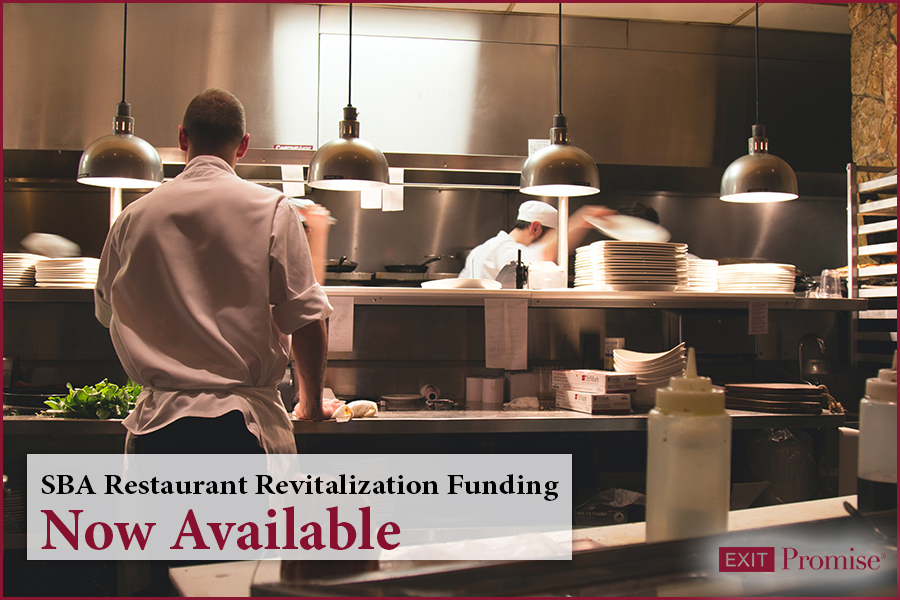- Maximizing After Tax Proceeds When Selling Your Business - June 7, 2024
- Understanding the Accredited Investor Rule 501 of Regulation D - February 27, 2024
- Which is Best – Business Broker, M&A Advisor, or an Investment Banker? - October 2, 2023

Have a Question?
Ask your Question below!
One of our investors or advisors will answer.
On Monday, May 3rd, 2021, the Small Business Administration (SBA) opened its application portal for the Restaurant Revitalization Funding (RRF) to certain restaurants, bars and other similar businesses that serve food and/or drink which have suffered a reduction in revenue in 2020 when compared to 2019 as a result of the pandemic.
Similar to the Paycheck Protection Program Loan (PPPL) program, this federally-funded program is intended to provide cash to businesses which have suffered revenue losses and if spent on the proper types of expenses within a specific period of time (the Covered Period), the loan may be fully-forgiven by the SBA.
Restaurant Revitalization Funding Eligibility
There are several knock-out provisions to ensure those businesses awarded the RRF are truly those the funding is intended to assist.
To be eligible for the RRF, the applicant must be able to prove its 2019 on-site sale of food and drink to the public was at least 33% of its total revenue. There are also provisions for businesses which began operations between January 1st, 2020 and March 10th, 2020 to benefit from the RRF.
Other applicant knock-outs for this program include:
State or Local government operations
Permanently closed businesses or those in Chapter 7 Bankruptcy
Chapter 11, 12 or 13 Bankruptcy, and not operating under a approved plan of reorganization
Own or operate as of 03/13/2020 more than 20 locations (including affiliated businesses)
Received a Shuttered Venues Operators Grand or have a pending application
Non-profit businesses
Publicly traded businesses
Certain Franchises under the provisions of 13 CFR 120.110
Similar to the PPPL and Emergency Economic Injury Disaster Loan (EIDL) SBA programs, the RRF applicants will be required to make a good faith certification that current economic uncertainty makes the funding request necessary to support the ongoing or anticipated business operation.
The Restaurant Revitalization Funding Covered Period
The funds made available through the RRF must be used for defined eligible expenses between February 15, 2020 and the earlier of the date the business may close permanently or March 11, 2023. This timeframe is the SBA’s definition of the Covered Period for the RRF program.
Given the fact that the SBA has provided for a retroactive covered period, it’s clear it intends to help businesses in the food and beverage industry to not only revitalize, but to also to restore their vendor relationships. It’s also important to understand that there is required interim SBA reporting regarding how the RRF funds are being spent.
Restaurant Revitalization Fund Eligible Expenses Include:
Payroll costs;
Business mortgage, rent, debt service, utilities payments;
Maintenance expenses;
Outdoor seating construction costs;
Business supplies;
PPE and cleaning products;
Products sold to customers (food items and supplies);
Raw materials to make beer, wine or spirits; and
Ordinary business operating expenses.
How Much Funding is Available to my Restaurant or Bar?
If your restaurant, bar or other qualified business was in operations before January 1, 2019, the calculation of the amount of your RRF funding is fairly straight forward. To be considered a business in operations, the business must have started making sales. It’s not sufficient for the business entity to have only been formed by filing with the state corporation office.
In this case, take the business’ gross revenue for each of its physical locations in 2020 and subtract it from the gross revenue in 2019. If that figure is positive, your business suffered a reduction in sales when comparing 2020 to 2019. Take that figure and subtract any amounts you received from the PPP Loans. Subtract both draws you may have received from the PPP Loan program.
If the end result is greater than $1,000 or less than $5,000,000, your business is eligible for the Restaurant Revitalization Funding program. If the amount is greater than $5,000,000, your RRF amount will be capped at $5,000,000 per location with a maximum of $10,000,000 per applicant (and its affiliates).
If your business had multiple locations, had not opened for business prior to January 1st, 2019, or started operations between January 1st 2020 and March 10th, 2020, there are other ways to calculate your business’ eligibility for the RRF. These calculations are found in the RRF application.
How to Apply for the Restaurant Revitalization Funding
If your business works with one of the two designated SBA Point of Sale Restaurant Partners Square or Toast, they will be able to assist you with your RRF application.
If not, you will need to have your business 2019 federal tax returns completed along with documentation to support your 2020 business gross revenue. Then go to restaurants.sba.gov to apply.
If you are not able to access the internet, you may apply at 844 279-8898.
SBA Allocation of Funding for the RRF
The SBA has set aside $9.5 Billion for this program and has offered an early window for businesses more than 50% owned by women, veterans and/or socially and economically disadvantaged individuals.
All eligible applicants may apply now. However, the SBA distribution of funding will be prioritized as follows:
The first 21 days (May 3 through 24, 2021), the SBA will distribute those who certify their business is more than 50% controlled by women, veterans or socially and economically disadvantaged individuals.
After May 24, 2021, the SBA will distribute funds in the order in which applications are approved.
The Restaurant Revitalization Funding program offers restaurants, bars and other food and beverage business owners more than a lifeline to stay open. It’s an unusual opportunity for any qualified business owner to rethink how they can move forward. Many business owners in this industry were able to pivot during the pandemic and for those who’ve survived, they may now have some real dollars to assist them in the long term. They may even thrive in our collective economic recovery.














I was a schedule c…have a small craft business selling dry dips and marinates at craft shows…would I be eligible for funding since shows were cancelled most of last year?
Hi Anita,
The RRF is meant to support businesses in the food and beverage industry that serve their products to consume on the spot. “Being served” food and drink is necessary in order to be eligible for the RRF money. The threshold for this is 33% of your sales must be food and drink being served.
All the best…